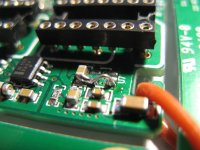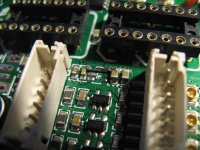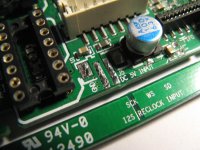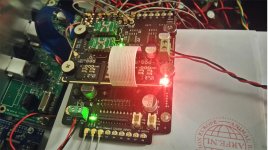Ian, I'm very impressed by the new MC FIFO board. Really amazing work! And very usable for "music only" applications.
I have one major concern with the current design; the MC FIFO couldn't be used for every application, because only with a 0.015s< MC FIFO delay(max. 15ms delay) the device is usable as an all-round device for video, music and gaming.
Will there be a future update of MC FIFO which is usable for every application? Do you see any improvement possible due a future firmware-update for example to improve the delay to a max of 15ms instead of the current 100ms? (or even lower, 10ms, the lower the better)
That would be more then great! In that case the board would be perfect!
And what do you mean with "Continue adjustment" in the quote stated above? Will this be de "lowest possible delay mode"? And if so; then how many ms delay will that be on average? I'm not able to find anything about this subject in the current documentation.
I'm looking forward to your reply, thank you in advance.
Kind regards,
Hi Guho,
With delay time continue adjustment, it is possible to set the delay time to 15ms( but not limited, you can set to 5ms, 10ms,20ms...too). Small upgrade need to be done to the McFIFO display/controller
(which is here: https://github.com/iancanada/McFIFOdisplay ).
You can set the delay time even shorter if you enable the MCLK slave control mode. This is the third generation Ian FIFO technology, a lot of things are possible.
Good weekend.
Ian
Ian where can I see a list of all your boards?
@sq225917
Just organized everything here on gitHub:
https://github.com/iancanada/DocumentDownload
Please let me know if you have any question.
Good weekend
Ian
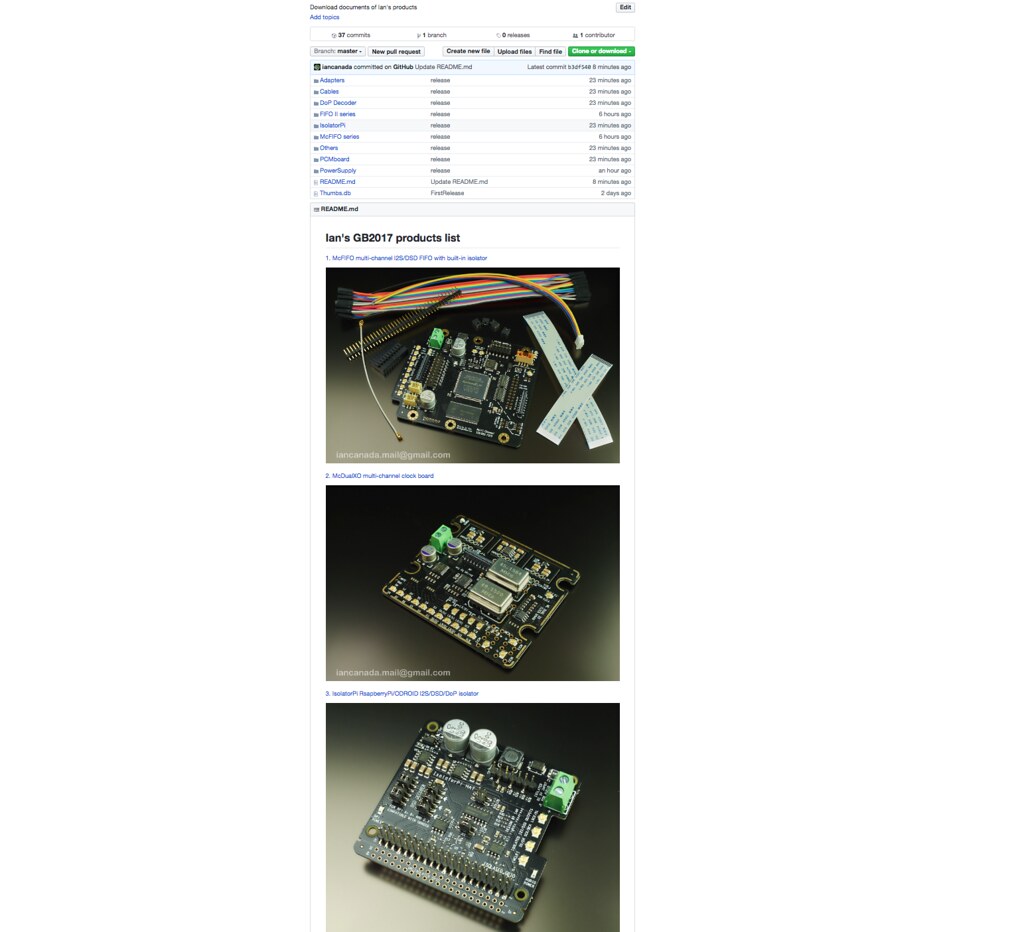
ghiHubList by Ian, on Flickr
Last edited:
Hi Guho,
With delay time continue adjustment, it is possible to set the delay time to 15ms( but not limited, you can set to 5ms, 10ms,20ms...too). Small upgrade need to be done to the McFIFO display/controller
(which is here: https://github.com/iancanada/McFIFOdisplay ).
You can set the delay time even shorter if you enable the MCLK slave control mode. This is the third generation Ian FIFO technology, a lot of things are possible.
Good weekend.
Ian
Hi Ian,
Thank you for your quick reply and the great solution!
You've really thought of everything with this project, I'm amazed by the professionalism and how flexible your approach is.
I just added myself to the group buy (of course
Kind regards and have a nice weekend also,
Guho
Hi Ian,
Thank you for your quick reply and the great solution!
You've really thought of everything with this project, I'm amazed by the professionalism and how flexible your approach is.
I just added myself to the group buy (of course), I'm really looking forward to the boards, I will send you a email with my details.
Kind regards and have a nice weekend also,
Guho
Thanks Guho for those good words.
Ian GB2017 is starting to run this weekend (I believe on Sunday, tomorrow), I'm busy working on it.
Regards,
Ian
Last edited:
Dear Ian,
I'm long time user (4yr+) your complete setup, and I have two of your clock boards already here - with regard to new (in the post) Pulsar clock 22.xxx, the original XO board would limit functionality to 88.2k only. Dual XO would have it 44.1k through to 176kHz. My question is there any advantage with such clock used with your Single XO, Dual XO or Dual XO II so far as phase noise : jitter/overall performance is concerned.
Thanks,
Shane
I'm long time user (4yr+) your complete setup, and I have two of your clock boards already here - with regard to new (in the post) Pulsar clock 22.xxx, the original XO board would limit functionality to 88.2k only. Dual XO would have it 44.1k through to 176kHz. My question is there any advantage with such clock used with your Single XO, Dual XO or Dual XO II so far as phase noise : jitter/overall performance is concerned.
Thanks,
Shane
Dear Ian,
I'm long time user (4yr+) your complete setup, and I have two of your clock boards already here - with regard to new (in the post) Pulsar clock 22.xxx, the original XO board would limit functionality to 88.2k only. Dual XO would have it 44.1k through to 176kHz. My question is there any advantage with such clock used with your Single XO, Dual XO or Dual XO II so far as phase noise : jitter/overall performance is concerned.
Thanks,
Shane
Hi Shane,
With 22.xxx MHz XO, you can run music up to 176KHz. Pulsar OCXO are super, so for the best ones you can touch.
Among single XO, dual XO, dual XO II, I would recommend dual XO II.
But the new McDualXO is better than all of them, it works for McFIFO only.
Have a good weekend.
Ian
Thanks Ian,
I performed the micro-surgery on the Dual XO board today, removing the onboard LDO's and J5 connector in anticipation for the pulsar ADM7150 regulator. Hopefully I can get it to fit properly, I can see why you have moved the DC input connector on the newer clock board !!. If I can get it to work properly, great, if not - I'll add my name to the GB list for the newer clock board.
Thanks again,
Shane
I performed the micro-surgery on the Dual XO board today, removing the onboard LDO's and J5 connector in anticipation for the pulsar ADM7150 regulator. Hopefully I can get it to fit properly, I can see why you have moved the DC input connector on the newer clock board !!. If I can get it to work properly, great, if not - I'll add my name to the GB list for the newer clock board.
Thanks again,
Shane
Seems no need for zero ohm SMD resistor if can jump via at U7, and simple straight line connection clear of redundant LDO pads for U8 .. if I'm missing something - please someone say something.
Thanks,
Shane
Thanks,
Shane
Attachments
@Ian:
While reading the McFIFO's manual I came across the section describing its serial port.
I have a couple of questions:
1) Is the signalling 5V tolerant?
2) The manual hints to this port being used (in the future?) to control the FIFO (instead of just receiving info on the FIFO's status). Is there a list of the available commands and their functions?
While reading the McFIFO's manual I came across the section describing its serial port.
I have a couple of questions:
1) Is the signalling 5V tolerant?
2) The manual hints to this port being used (in the future?) to control the FIFO (instead of just receiving info on the FIFO's status). Is there a list of the available commands and their functions?
!
Hi Shane,
No problem you do it this way. You did good job!
Enjoy with your innovation
Regards,
Ian
Seems no need for zero ohm SMD resistor if can jump via at U7, and simple straight line connection clear of redundant LDO pads for U8 .. if I'm missing something - please someone say something.
Thanks,
Shane
Hi Shane,
No problem you do it this way. You did good job!
Enjoy with your innovation
Regards,
Ian
@Ian:
While reading the McFIFO's manual I came across the section describing its serial port.
I have a couple of questions:
1) Is the signalling 5V tolerant?
2) The manual hints to this port being used (in the future?) to control the FIFO (instead of just receiving info on the FIFO's status). Is there a list of the available commands and their functions?
@ Dimdim
1. All input I2S/DSD signals are 5V toleranced.
2. All available commands can be hacked from source code here:
https://github.com/iancanada/McFIFOdisplay/blob/master/FifoDisplay/FifoMessage.hpp
If you want, you can modify the code, or design the panel for my McFIFO by your own.
Regards,
Ian
1) I was asking about the RX & TX lines of the serial port.. I see that the same jack gives out 5V but I'm not sure that the serial line logic levels are at 5V. Anyway, I have the board now, I can just scope them out. 
2) I knew about these commands, what I was asking about was whether there exist commands that can be sent from the Arduino to the McFIFO to control (for example) the FIFO length.
I will definitely add support for the McFIFO into my Arduino projects (ES9018, Soekris, and upcoming Dual AK4490 and ES9028/9038).
2) I knew about these commands, what I was asking about was whether there exist commands that can be sent from the Arduino to the McFIFO to control (for example) the FIFO length.
I will definitely add support for the McFIFO into my Arduino projects (ES9018, Soekris, and upcoming Dual AK4490 and ES9028/9038).
1) I was asking about the RX & TX lines of the serial port.. I see that the same jack gives out 5V but I'm not sure that the serial line logic levels are at 5V. Anyway, I have the board now, I can just scope them out.
2) I knew about these commands, what I was asking about was whether there exist commands that can be sent from the Arduino to the McFIFO to control (for example) the FIFO length.
I will definitely add support for the McFIFO into my Arduino projects (ES9018, Soekris, and upcoming Dual AK4490 and ES9028/9038).
@Dimdim
1. Both TX and RX are 5V logic level toleranced.
2. It's possible to send command from Arduino to McFIFO to control FIFO length, but that command is just not available for now. I'll let you know once it's ready. It won't take too long.
Regards,
Ian
I received it today. The sound is awsome. I Test it with a dual ak4490. Thank you very much Ian.
You are the first one set up McFIFO project. Congratulations!
I saw your u.fl cables, I'm just wondering how many DACs you are running?
Good luck to your project!
Ian
- Home
- Source & Line
- Digital Line Level
- Asynchronous I2S FIFO project, an ultimate weapon to fight the jitter
